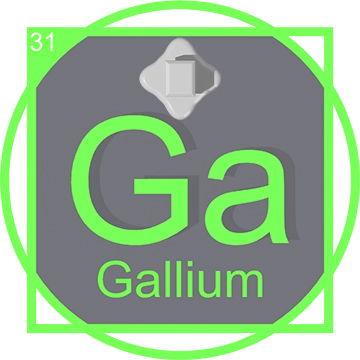Unveiling Gallium (Ga): A Keystone in Modern Technology
Introduction to Gallium
Gallium, with the chemical symbol Ga and atomic number 31, is a fascinating metal known for its unique properties and versatile applications. Discovered in 1875 by French chemist Paul-Émile Lecoq de Boisbaudran, Gallium has become indispensable in various high-tech industries.
Discovery and Historical Significance

The discovery of Gallium was noteworthy as it was predicted by Dmitri Mendeleev's periodic table before it was physically isolated. Its discovery not only confirmed the accuracy of Mendeleev’s predictions but also showcased the predictive power of the periodic table.
Role in the Periodic Table
Gallium is positioned in Group 13 of the periodic table, placing it among the post-transition metals. This group is also part of the aluminum family, which explains some of Gallium's aluminum-like characteristics.
Future Prospects
The future of Gallium in science and technology looks promising. Researchers are continuously uncovering new applications and improvements in existing technologies leveraging Gallium's unique properties.

- Photovoltaic Innovations: Ongoing research is exploring the use of Gallium in new types of photovoltaic cells. These developments are not only expected to enhance the efficiency of solar panels but also reduce manufacturing costs, potentially revolutionizing solar energy.
- Medical Diagnostics: Gallium isotopes are being investigated for their potential use in radiopharmaceuticals, offering new ways to diagnose and treat various diseases.
- Cooling Systems: The unique thermal properties of Gallium are being utilized to develop innovative cooling solutions for electronic devices, potentially overcoming current limitations in heat management technologies.
Scientific and Technological Applications
Gallium's impact on technology is profound, with its compounds playing critical roles in various high-tech industries.
- Semiconductor Technology:
- Gallium arsenide (GaAs) is used in the production of integrated circuits and solar cells, prized for its superior electron mobility compared to silicon.
- Gallium nitride (GaN) is vital for LED technology and is increasingly used in high-frequency, high-power electronics due to its ability to operate at higher voltages.
- Thermal Management: Gallium's low melting point and high boiling point make it ideal for use in high-temperature thermometers and heat transfer applications, such as in nuclear reactors and electronic cooling systems.
Exploring the Unique Characteristics of Pure Gallium

Gallium, with its symbol Ga and atomic number 31, is a fascinating element that exhibits some unique physical properties in its pure form. At room temperature, pure Gallium presents as a soft, silvery metal that is so malleable, it can be cut with a knife. Notably, Gallium has a melting point of about 29.76°C (85.57°F), which allows it to melt in the palm of one's hand. Despite this low melting point, it has an unusually high boiling point of 2204°C (3999°F), making it stable even at high temperatures. These characteristics make Gallium particularly interesting for scientific experiments and various applications in electronics where temperature-sensitive materials are required.
Production and Sources of Gallium
Gallium is not found in free form in nature but is extracted from the byproduct of aluminum refining and the processing of certain zinc ores. Most gallium is sourced as a byproduct of bauxite and sphalerite mining, where it accumulates in small amounts that can be commercially extracted.
- Major Sources: The primary sources of gallium include countries with extensive bauxite mines such as Australia, China, and Brazil.
- Commonly Found With: Gallium is typically found alongside aluminum and zinc, as it is extracted from the ores of these metals.
Current Applications
Today, gallium's unique properties make it invaluable across several high-tech industries:

- Semiconductors: Gallium arsenide (GaAs) and gallium nitride (GaN) are critical in the manufacture of devices like integrated circuits, solar cells, and LEDs.
- Medical Applications: Its use in thermometers and high-contrast imaging agents in medical diagnostics.
- Telecommunications: Gallium compounds are also essential in the production of mobile phones and satellite communications.
Future Prospects
The potential for gallium in future technologies continues to expand:

- Photovoltaics: Research into gallium-based alloys in solar panels aims to create more efficient alternatives to traditional photovoltaic materials.
- Advanced Electronics: Development of next-generation semiconductor materials that can operate at higher voltages and temperatures.
- Medicine: New medical technologies utilizing gallium's anti-inflammatory and antimicrobial properties are under investigation.
Conclusion
As technology evolves, the demand for gallium is expected to grow, particularly given its role in green technologies and advanced electronics. Understanding gallium’s properties, sources, and applications helps anticipate future trends in these critical sectors.












